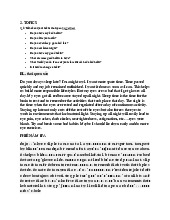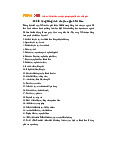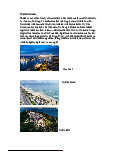



Preview text:
In the eld of leisure and tourism
In the field of leisure and tourism, production and consumption are increasingly
becoming integrated as the barriers between work and leisure, and between different
economic sectors become vaguer (Gospidini, 2007):
Cultural and leisure production and consumption (of arts, fashion, music, food,
tourism), creative industries of technology-intensive and knowledge-rich
enterprises containing design (in architecture, fashion, graphics, internet, etc),
new media and ICTs have become the growth engine of the post-industrial city (p. 11).
Developing practices of production and consumption are at the forefront of the
creative turn, with a symbiotic relationship between a productive drive towards
developing new experiences and consumer desires for new sources of ‘fun’ and
distinction (Pantzar and Shove, 2005).
In terms of production, the rise of creativity is often linked to the development of the
‘experience economy’ (Pine & Gilmore, 1999; Poulsson & Kale, 2004), in which
growing competition arguably leads producers to add value to services by developing
‘experiences’. Tourism became an important driver of this process, with the
development of specific experience environments and the repackaging of a range of
tourist services as ‘experiences’. As the experience economy leaned heavily on the
development of themed and staged experiences, the importance of symbolic
production (Lash & Urry, 1994) and the role of the ‘creative industries’ as a major
source of symbolic content for tourism became more obvious. Tourism has become
part of the cultural or symbolic economy, as Gibson & Kong (2005) note:
many sectors (including industries such as furniture and industrial design, certain
forms of niche food production and tourism) may now be viewed as part of the
cultural economy because of their symbolic content, when they were at best only
peripherally considered part of 'the arts' previously (p. 543).
Commentators on the rise of the symbolic economy, including Zukin (1995) and
Hannigan (1998) have pointed to the leading role of tourism, media and entertainment
in symbolic production. “Cultural strategies of redevelopment are complicated
representations of change and desire. Their common element is to create a ‘cultural’
space connecting tourism, consumption and style of life” (Zukin, 1995, p. 83).
The creative development of tourism production also stems from the nature of tourism
itself. As with many other service industries growing competition forces enterprises to
move up the value chain, evolving new sources of value (Pine & Gilmore, 1999). This
process has also been evident in cultural tourism, where the increasing supply of
cultural products has in many cases outstripped demand (Richards, 1996), increasing
competition and driving a search for alternative models. As Russo (2002) has pointed
out, cultural tourism has become subject to a vicious cycle of overdevelopment,
reducing returns and lack of investment, which has undermined the value of cultural
tourism for many destinations. One response has been a shift from cultural tourism
towards creative tourism and creative development strategies (D’Auria, 2009), thereby
arguably producing more flexible and innovative forms of tourism experience which
are harder to copy or imitate than mere services (Alvarez, 2010).
The shift towards creative production has also been stimulated by the increased
attractiveness of creative occupations. As McRobbie (2007) has argued in the case of
the UK, the creative sector is increasingly characterized by precarious forms of labour
which are sustained by a belief in the ‘one hit wonder’ which will deliver riches and
fame. The creative industries can therefore count on a significant pool of part-time and
casual workers, many of whom will try and increase their career prospects by building
their creative networks, attending parties and events in creative and cultural locations
which attract other would be creative stars (Currid, 2007). Artists are also often seen
as the pioneers of urban regeneration. As Zukin (2010) has shown in the case of New
York, artists are often the first to move into rundown neighbourhoods in search of
cheap space, kick-starting a gentrification process which eventually leads to upgrading
of the area and the growth of tourism.
A number of trends in the field of consumption also point to an increasingly important
role for creativity in tourism. Among the key consumption trends linked by Richards
& Wilson (2006) to the rise of creativity are:
· Dissatisfaction with contemporary modes of consumption
· Blurring boundaries between work and leisure (serious leisure, work as play, lifestyle entrepreneurship)
· Increased desire for self-development and skilled consumption
· Experience hunger of postmodern consumers
· Building narrative, biography and identity
· Attractiveness of creativity as a form of expression The platform:
The model introduces the whole process that clarifies how to create initiative at the
local level through four forms of delivery. Look and Shopping are traditional forms of
tourism activities and also be considered as background of creativity in tourism. For
traditional tourism, tourists typically engage in activities such as sightseeing, visiting
unique landmarks and landscapes, shopping, rather than directly participating in
adventurous sports, engaging in local culture, or learning about the history and culture
at the destination. Traditional tourism focuses on pre-existing natural landscapes or human-made structures. - Advantages:
+ Attract tourists to existing and famous places in the world.
+ Does not waste time or effort to create new tourism products.
+ Relaxation and Spiritual Upliftment: Traditional tourism allows travelers to relax,
escape from their daily lives, and enjoy the beauty of natural surroundings or scenic landscapes. - Drawbacks:
+ Depends on the seasonality of tourism.
+ Countries with geographical and natural limitations are difficult to compete with.
+ Lack of cultural interaction: Sightseeing-focused tourism often doesn't prioritize
interacting with the locals or engaging in local culture.
+ Lack of diversity in activities: By focusing solely on sightseeing, tourists miss out
on the opportunity to participate in a wide range of activities such as trying local
cuisine, engaging in outdoor adventures, or learning about local culture.
+ This is an unsustainable development direction because structures, buildings or
natural landscapes will be eroded over time.
Innovative activities in tourism bring novelty and uniqueness to everyone's
travel experience. It's important to start with planning the trip. Visitors can
design their own schedules, including unknown destinations or unique tourist
activities. This provides an opportunity to explore places that few people have
set foot in and experience personalized.
An important part of creative activity is exploring local culture. Visitors can
take part in activities such as learning local cooking, attending festivals, or
learning about local culture and history. This helps them create creative
memories and deeper understanding of the country they're visiting.
Besides, engaging in outdoor activities is also an interesting way to show
creativity. Mountain climbing, diving, or cycling through beautiful landscapes
all offer exciting and unique experiences.
Visitors can also create unique experiences by attending classes, watching art
performances, or even doing creative activities on their own like painting or writing a travel diary. - Advantages:
+ Preserving and promoting the development of intangible cultural heritage
+ This type of tourism takes advantage of the value of the knowledge,
experience, life skills of the indigenous people so it is very difficult to copy and
bring a very unique experience
+ Create conditions for lands that have no geographical and natural advantages
that can attract tourists with historical and cultural values - Disadvantages:
+ It takes time, people and money to research, discover new and innovative tourism products
+ difficulty in exploiting and demonstrating inherent cultural characteristics + involvement of local people



